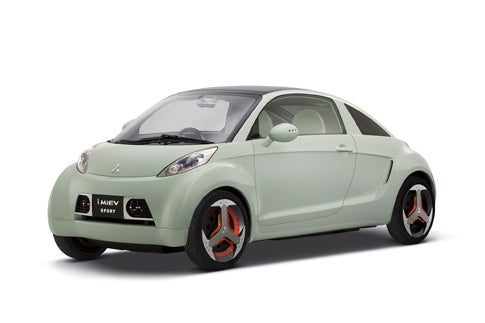Three Bodacious Green Innovations
Clever planet-fixing inventions

Plug-N-Play Cars
Zero to 60 mph in about nine seconds may sound sluggish, but it’s a breakthrough for a zero-emissions, all-electric car that can travel up to 100 miles on a single charge and hit speeds of 85 mph. That’s the claim of the i MiEV (for “Mitsubishi Innovative motor Electric Vehicle”), a new plug-in four-door coupe. The i MiEV runs on a pack of 22 lithium-ion batteries, but unlike other electric cars, including the Chevy Volt and Tesla Roadster, the i MiEV doesn’t require a liquid cooling system to avoid overheating.
“Proprietary metals in the battery design let us do away with it,” says Moe Durand, the communications manager for Mitsubishi Motors North America.

Driver’s Seat: Look for Mitsubishi’s lineup to start incorporating the i MiEV’s energy-saving windows and interior
This makes the i MiEV lighter and more efficient, which — combined with a small, rear-mounted electric motor — gives it plenty of zip and extended range. The company is also developing a two-door i MiEV Sport with a planned top speed of 122 mph and a 124-mile range. Still a concept, the sportier version will have a rootop photovoltaic panel for extra power, heat-deflecting windows to save AC, and an interior made from polymer-producing plants. Mitsubishi is now fleet-testing the four-door in the U.S. and will sell a $28,000 model in Japan this summer.

Sunny Side Up: A new type of asphalt converts the sun’s rays into electricity
Electric Asphalt
You know that saying about frying an egg on a hot sidewalk? It works, says Rajib Mallick, an engineer at Worcester Polytechnic Institute who studies the effect of solar radiation on cities. Now Mallick has devised a way to harness heat from baking blacktop and turn it into electricity. His system pumps water — an excellent heat conductor — through a network of copper pipes embedded in asphalt. As the water circulates, it pulls heat from the scorching surface and produces steam to drive a turbine that cranks out electricity. Mallick is partnering with the University of Massachusetts Dartmouth and the optics firm Novotech to install a full-scale system beneath a 10,000-square-foot parking lot near Worcester, Massachusetts, next summer. By supplying electricity to the adjacent buildings, he expects the $200,000 system to pay for itself in energy savings in a decade.

Solar Solution: The Solar Cube is the first desalinator to run on renewable energy
Smart Water
Making seawater drinkable for the millions without access to freshwater is a noble idea, but a standalone desalinator needs 17 gallons of diesel fuel and 66.5 kilowatts of electricity to make 1,000 gallons of freshwater. The Solar Cube, made by Spectra Watermakers in California, churns out 1,500 gallons of drinking water on just 22 kilowatts of its own solar and wind power. The innovation is a pump that triples efficiency by recapturing hydraulic pressure during the filtering process. Solar Cubes are now bringing freshwater to remote regions of South Africa, Pakistan, Venezuela, Chile and other places short on infrastructure and electricity.